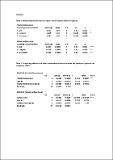Por favor, use este identificador para citar o enlazar a este item:
http://hdl.handle.net/10261/341222COMPARTIR / EXPORTAR:
 SHARE SHARE
 CORE
BASE CORE
BASE
|
|
| Visualizar otros formatos: MARC | Dublin Core | RDF | ORE | MODS | METS | DIDL | DATACITE | |

| Título: | Macrophyte complexity influences habitat choices of juvenile fish |
Autor: | Hinz, Hilmar CSIC ORCID ; Anglada, Paula; Gayà Vilar, Alberto; Reñones, Olga CSIC ORCID; Catanese, Gaetano; Castro-Fernández, Julia CSIC ORCID; Gil, María del Mar CSIC ORCID; Grau, Amàlia CSIC ORCID; Moranta, Joan CSIC ORCID | Palabras clave: | Ecosystem functions Algae habitats Nursery habitats Juvenile fish behaviour Environmental change |
Fecha de publicación: | 30-ago-2023 | Editor: | Springer Nature | Citación: | Marine Biology 170 : 125 (2023) | Resumen: | The nursery function of littoral habitats for juvenile fish is widely recognized, but data on the specific habitat features that contribute to this function is sparse for many species, in part related to the difficulty of studying juvenile fish in their natural environment. However, this information is required to understand the potential risks of environmental change to the nursery functions of habitats. In this context, the habitat choice behaviour, with respect to differences in structural features, was evaluated for three Mediterranean littoral fish species known to be associated to macrophytes as juveniles. The overarching aim of this experiment was to determine if juveniles actively choose between different macrophyte configurations of varying complexity and height. Juveniles were exposed simultaneously to multiple visual habitat stimuli within an experimental choice arena, and their swimming behaviour was tracked by video recordings to determine the amount of time they spent near each habitat configuration. All three species showed a clear association in their occupancy towards more complex habitat configurations demonstrating that juveniles distinguished and actively selected habitats using visual cues. Subtle differences in species' affinity for complex habitats allowed us to appraise their potential vulnerabilities to habitat loss in the Mediterranean under environmental change scenarios. Furthermore, the results of this study provided evidence that differences in juvenile distribution between habitats found in previous observational studies may indeed be caused by active habitat selection, as well as through differential survivorship rates. | Versión del editor: | http://dx.doi.org/10.1007/s00227-023-04255-8 | URI: | http://hdl.handle.net/10261/341222 | DOI: | 10.1007/s00227-023-04255-8 | Identificadores: | doi: 10.1007/s00227-023-04255-8 e-issn: 1432-1793 issn: 0025-3162 |
| Aparece en las colecciones: | (IEO) Artículos (IMEDEA) Artículos |
Ficheros en este ítem:
| Fichero | Descripción | Tamaño | Formato | |
|---|---|---|---|---|
| Hinz_Macrophyte complexity2023.pdf | 1,92 MB | Adobe PDF |  Visualizar/Abrir | |
| Suplem_Hinz_2023_227_2023_4255_MOESM1_ESM.pdf | 638,85 kB | Adobe PDF |  Visualizar/Abrir |
CORE Recommender
Page view(s)
16
checked on 23-abr-2024
Download(s)
20
checked on 23-abr-2024
Google ScholarTM
Check
Altmetric
Altmetric
Este item está licenciado bajo una Licencia Creative Commons

